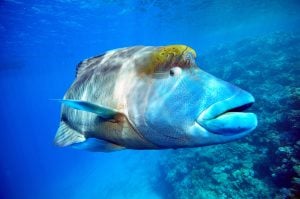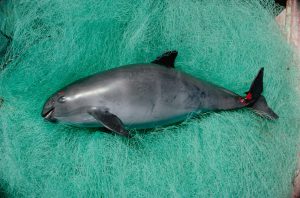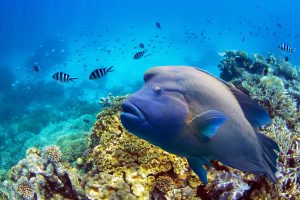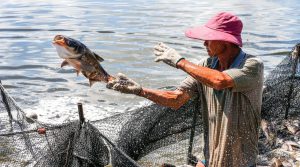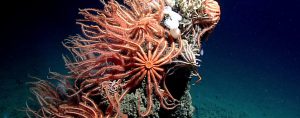Marcy Trent Long: This is Marcy Trent Long. Welcome to Sustainable Asia. Three Billion is a four-part podcast series about the seafood trade in Hong Kong, China and Asia. It’s made in collaboration with chinadialogue and sponsored by Swire Group Charitable Trust.
Stan Shea: So we’re in Hong Kong, here is called Sheung Wan. It’s actually a famous place for buying dried seafood. And Sheung Wan is a very local, traditional community area. You can still see a lot of old shops. Dried seafood shops are always family businesses. They’re still very traditional, nine to five, and they close on Sunday.
Marcy: That was Stan Shea. He’s a marine biologist for the conservation group Bloom Association. He walked me through the Sheung Wan district, the heart of the Hong Kong seafood trade.
Stan: In the past, the port used to land right here, so the things would come in, with unloading and loading here. So a lot of the wholesalers, their warehouses are actually stationed here.
Marcy: In earlier days, local Sheung Wan fishermen used to catch 90% of their fish in Hong Kong waters. But now as they venture farther and farther into the South China Sea, these small Sheung Wan fishing stalls have become major seafood trading businesses. The question is, can the supply of traditional seafood products keep up with their growing demand?
Stan: Dried seafood is a part of Chinese tradition. But we know now that we’re eating faster than they can reproduce. So someday, [there’ll be] no more tradition. We’re eating our own tradition.
Marcy: In our previous series, 1986, we talked about overfishing in China’s territorial waters. In this series, we’ll tackle the seafood trade worth US$3 billion in Hong Kong and mainland China. Why are we talking about the seafood trade? Because earlier this year, the United Nations published a crushing report on biodiversity. One million species on the planet are at risk of extinction. What are some of the species that have moved to the top of everybody’s list? Ocean marine species. Those cute seahorses, toothy sharks and big-eyed groupers – many of them are being fished to extinction.
Stan: Hong Kong is actually one of the highest seafood consumption places in the world.
Marcy: In Hong Kong, we consume four times more seafood than the global average. Over 70 kilogrammes or 150 pounds of seafood per person each year! Throughout this podcast series, we’ll talk to experts like Stan Shea here in Asia, who are working to protect marine species, how they’re doing it, and what are some of the challenges they’re facing. But before we do that, we first need to understand why seafood, including some endangered marine species, are such an integral part of Chinese culture.
Marcy: So we’re clearly in a noisy part of Sheung Wan, and it’s even started raining on us. They’re loading and unloading shipments into the variety of the stores. But Stan, maybe you could just describe to us what you see on this road of the different types of stores and what the different types of stores might be selling.
Stan: I think for the dried seafood area in HK, we eat almost anything. So for example dried shark fin, dried fish, dried abalone, dried starfish, even dried squid, scallop and octopus. But mainly in the area, the most profitable are those from the sea cucumber, shark fins and abalone, and also the fish maw.
Marcy: Sea cucumber, shark fin, abalone and fish maw.
Tony: Bao sam chi tou.
Marcy: Also known as the “four treasures” of Chinese cuisine. I spoke with some Chinese friends to learn how important these seafood treasures are in Chinese culture.
Penney: Bao sam chi tou. “Bao” is abalone…
Tony: “Sam” is “hoi sam”, which is sea cucumber, “chi” is shark’s fin.
Penney: “Tou” is fish belly.
Tony: It’s some sort of fatty part of a fish stomach. [“Tou” is actually fish swim bladder. Ed.]
Marcy: These four treasures are considered delicacies in Chinese cuisine, and are mostly served on special occasions.
Penney: Usually when it’s time to celebrate.
Tony: When you have honoured guests over.
Penney: Like Chinese New Year, like at weddings.
Derek: Or you wanna celebrate a certain success.
Penney: Or someone’s birthday banquet.
Derek: Opening of a new business…
George: There’s always one on the table.
Derek: Shark fin itself is tasteless. It’s the base soup that’s tasty.
George: It tastes like nothing. But it’s the prestige that comes with it. Usually I’d see shark fin during business dinners. And they serve it as a sign of respect almost, that we value the fact that you’re having a meal with us.
Penney: In Chinese culture, you want to give the best when you’re having a banquet, when you’re entertaining your friends.
Derek: In order to show that you have achieved a certain level of wealth, or not just wealth – achieved success in a business, for example, it is their honour to spend on their relatives and friends and family [and serve] these sort of delicacies.
Marcy: So these four luxurious treasures are essential to any big celebratory banquet. But that’s not the only way seafood plays a role in Chinese culture. When I first came to Asia, I was intrigued by how even the tiniest restaurants would have tanks of live exotic fish on display. You could just walk up to the glass tank and point to the fish you wanted for dinner. And I wasn’t the only one who was amazed by this tradition.
Yvonne Sadovy: I’d never come across it before. I’d seen lobsters in tanks before in many Western restaurants, but I’d never seen live fish – colourful, beautiful reef fish.
Marcy: That’s Yvonne Sadovy. You may remember her from our previous series, 1986. She’s a professor at the University of Hong Kong, where she studies the trade in live reef fish.
Yvonne: So customers come along. They will select their fish in a tank. That will be taken then live to the restaurant, cooked fresh. And people are prepared to pay a very high price.
Marcy: Yvonne worked on grouper fish in the Caribbean before coming to Hong Kong. So she easily recognises them in Hong Kong’s seafood tanks, however…
Yvonne: I also started noting species of grouper I’d never seen before. And I should know, because I work on them. So when I look these up, I suddenly find that here in Hong Kong is an endemic from the Seychelles. What that means is, that fish only occurs in the Seychelles, which is of course a big island off East Africa. So I suddenly realised, it made me realise just how massive this trade is. They’re coming from everywhere.
Marcy: This raised some alarm bells for Yvonne. Reef fish, those beautiful fish that you swim around while you’re snorkelling, are very easily overfished. They’re so desirable that fishermen go to great lengths for this valuable catch. But if these fish were coming in from as far as the Seychelles in Africa, was anyone checking how many were left? Together with Stan, who we spoke with earlier, and several other concerned conservationists, Yvonne started investigating this further.
Yvonne: So we did this study because, throughout the region, it’s very clear that reef fishes are going, they are declining, and in some places pretty much they’re gone in terms of a viable fishery. And this is a problem for the species, because they’re not being fished sustainably, and it’s a problem for the communities in these countries, who depended in the past on these fishes.
Marcy: A number of these reef fish are now considered endangered and at risk of extinction.
Yvonne: It’s a very, very valuable trade. They’re part of the luxury, really high-end seafood trade within China. And there are massive profits that are being made, particularly downstream along this trade… the retailers, the traders and what have you. And so [there’s] a lot of pressure from the traders to get as much fish as they can as quickly as possible from wherever they can throughout the region.
Marcy: It seems as though the seafood trade is driven only by short-term profit, with little attention paid to the long-term availability of the seafood itself. In other words, are we fishing these marine species to extinction? To learn more, I asked Yvonne: “How does a live fish make it from the coral reefs along the coast of Africa or Southeast Asia to a fish tank in a restaurant on my street?”
Yvonne: The way the live fish trade works is… Let’s take Indonesia, because that’s the major exporter. Across the country, now, there are many, many communities which catch say live groupers, or catch Napoleon or other reef fish. And the fishermen will catch them, maybe a few a day, maybe even a couple a week. Then those are consolidated in a cage, a floating cage, usually owned by a trader or a consolidator. And when there’s a big enough volume, one or two tonnes, then they will call a vessel, and the vessel will come and collect the fish from the floating cages. And these vessels will time their trips to visit many, many different floating cages. A single vessel could hold up to 40 tonnes of fish for example. When they’ve finished picking everything up and they have a full vessel, most of them with live reef fish will go back to Hong Kong.
Marcy: Because China charges customs duties on endangered reef fish, these fish are first shipped to Hong Kong, where they can avoid the customs duties, and then smuggled on into mainland China. Official numbers say that over 99% of the reef fish these ships bring into Hong Kong are not exported onwards. But in conversations with fishermen and traders, Yvonne and her team found out that this number can’t be right. Actually, about 70% of the reef fish that come into Hong Kong are smuggled on to mainland China, making this trade wildly under-reported and illegal.
Yvonne: The kind of frustrating thing is that we could have a legal trade, which would ensure we have our fish now and into the future. So it’s a massive frustration that even despite the attempts by the Indonesian government – and they’re really genuine attempts, I work quite a bit with colleagues there – the illegal activities, particularly by Hong Kong vessels, I’m really sorry to say, is helping to drive this trade to being one that is largely illegal, and therefore unsustainable. And it will mean that we don’t have nearly as many of these species in the future.
[Break to thank sponsors]
Marcy: By the time we notice some species are disappearing, they’ve often declined beyond recovery. But if fishing vessels are coming into another country’s territorial waters, like Indonesia, why can’t local authorities just go and arrest them?
Yvonne: The countries where these fish are coming from have very little ability to manage their resources.
Marcy: So one of the problems is that smaller, developing countries don’t have the funds to go after these poachers. To understand this better, I spoke with Gary Stokes, who used to be Sea Shepherd’s man in Asia, but now he runs his own NGO called Oceans Asia. I could listen to Gary for hours as he talks about his adventures chasing poachers on the Asian seas. But here is just one story, from when Gary was working in the waters of East Timor, a tiny nation between Indonesia and Australia.
Gary Stokes: So I had been tracking these Chinese vessels – a fleet of 15 Chinese shark fin boats – and they had been caught offloading sharks onto a reefer ship right off the coast, 100 metres off the coast. And they were supposed to only be fishing for just broad-scale fish, not sharks. The Timorese have no marine capabilities to be able to actually go out and monitor, and police and enforce their waters. So I put together this idea that I wanted to take the Ocean Warrior, which was currently sitting in Fremantle and was about to go off to Africa. So it had a small window of six weeks, and I managed to get the ship and went up there, unannounced, didn’t tell anybody because we were technically going into their waters without permission. I didn’t know who in the government I could trust at that time.
So I found these 15 boats 200 miles offshore, and they were all there with their nets in the water fishing for shark. So we were just alongside filming, documenting them just picking up shark after shark after shark. I had the drone up, I had the drone right above them as they’re killing all these sharks. And then we followed them back up, and there was a big storm coming down, and they sheltered in a bay. So we loaded up the Ocean Warrior with some police, and off we went. Overnight. We raced down.
The bizarre thing was, I’m sitting there at two in the morning with a load of police with machine guns, teaching them how to do a boarding and how to detain a vessel. Because these were land police. These weren’t the marine police. The marine police worked very closely with the fisheries minister, who was likely the corrupt one who was protecting these Chinese fishing vessels. So even the police had said: “Do not tell the marine police.” So I had all these land cops on there, and they were turning green, they were throwing up everywhere. So we’re teaching them how: we’re coming in, we’re going to board here, you’re gonna climb over this, you’ve got to go up these ladders, get to the bridge, take everybody down to the back of the ship. And then two of you sweep the ship and find anybody else, and once you’ve got everybody at the back, signal us and then we’ll come on. We’ll put two crew on, we’ll go through their paperwork, go through all their holds, have a look and see what there is. So, yeah, it was serious.
So we boarded, opened up the fish hold, and it was just full. And it was horrific. Going down into those holds and just seeing them. We’re talking tens of thousands of sharks in each boat. They’d been out for a month and a half. We calculated they were killing about 85,000 sharks a month. And that was just 15 boats. So when people say, you know there’s always this magic number that people bounce around: 100 million sharks die every year. It’s baloney. I mean we’re talking 200, 250 million easily. China’s got over 4,500 deep-sea boats. Japan’s got close to similar, Taiwan not far behind, Korea… And that’s just four countries. And you think about the rest around the world, the Spanish fleet, Spain being the largest exporter of shark fins to China. You know. We’re all killing all the sharks.
Marcy: I always thought shark meat was a Chinese problem. I’d heard stories about fishermen catching sharks, cutting off their fins and selling those fins into the Chinese market. But Gary told me something really surprising, which is that these days, fishermen catch the entire shark, and they’ve found a market for each part of it.
Gary: I started using the hashtag quite a few years ago called “global shark crisis” because, especially on social media, everybody’s always blaming China. It’s: “China’s killing all the sharks, China’s doing this, China’s doing that.” And it’s not. You know, sharks are coming from Spain, they’re coming from Australia, they’re coming from India, they’re coming from Africa. The fleet that we found in Timor, they were taking the entire shark and they were literally – fins went in one pile, meat in another, skin in another, cartilage in another, liver in another. And they all went out to different industries. And we tracked one of those companies. The meat company was selling the meat to Australia, to Brazil, to the Philippines, to Mexico.
Marcy: Thankfully, most people now know sharks are more than bloodthirsty Jaws, and even in Asia, actors like Jackie Chan and basketball player Yao Ming have put their celebrity face on several, largely successful, shark fin campaigns. So with his new NGO, Oceans Asia, Gary thought it was time to expand beyond shark fin.
Gary: One of the things that we want to focus on is [to] bring the attention to these species that are not getting the attention they deserve. They are getting strip mined out of the ocean. [In] the delicate ecosystem that we live in, every single species has a role to play. And yet we’re focusing on one or two key species, and meanwhile the rest are being completely decimated. You’ve only got to go down to Sheung Wan and see how many shark fins are there. Everybody notices those, but nobody notices the sea cucumbers, the abalone, the starfish, the seahorses and everything else that you can’t even identify what it is. It’s all dried, nobody really knows the difference.
So we decided we would try and change that. The four treasures of the sea is our first target. But yeah, the scale and the magnitude that we’re seeing now with even just these four species is just ridiculous. The ocean can’t sustain having that many taken out.
Marcy: OK, I get now how these seafood poachers work, and how those involved seem to be driven only by profit without considering whether their fishing catch will be in the ocean tomorrow. It’s a problem of all fishing in general. Individuals are motivated to take the last fish available, otherwise the next guy gets it.
Yvonne: We need to develop a system of trade, along the length of the trade chain from source to consumer, from reef to restaurant, as they say, that is traceable, legal, sustainable. And we can do it, but we need all the actors to be part of that system to make this work. And it’s frustrating because you can see what needs to be done, but it’s so difficult to make it happen. So you have to have all of these pieces in place. The fishing part, the trading part, the governments controlling both the export and import, and even the consumers, what they will and will not choose to eat.
Marcy: Seafood is such an important part of life here in Asia. But I’ve noticed over many years in Hong Kong that local attitudes towards shark fin have changed. So maybe awareness campaigns can also help us end the trade in unsustainably fished seafood? After our walk through the Sheung Wan dried seafood market, I brought Stan Shea of Bloom Association back to the studio to hear his thoughts.
Stan: Now in Hong Kong we see the trend, as the young people actually try to shift. So for example, a hotel, you can see they do not serve shark fins, and they still survive. They use other things to replicate or replace [with a] substitute, [another] luxury product or seafood product. So that’s why it’s important to make sure the hotel has a policy on serving sustainable seafood, that makes sure even those other luxury seafood products are also from a sustainable source. And we have seen a couple of hotels actually doing that.
I actually, in September 2018, in my wedding, we worked with the banqueting team to find a sustainable source, and they actually found that not challenging, but actually enjoyable and interesting. They said they never had those requests. And we actually worked together, and the whole dinner was sustainable seafood, and nobody was complaining. And we can see more young people actually moving to that side. And so I think the banqueting can help in changing [things].
Marcy: According to chinadialogue: “The world is currently on track to miss most of the global targets set under the UN Convention on Biological Diversity.” China is a key factor in this, as seafood demand increases with economic prosperity. Luckily, in 2012, China’s leader Xi Jinping announced that the country would start its transformation towards an ecological civilisation. In response, China is hosting its first ever UN conference on biodiversity next year in 2020.
But old traditions are slow to change, and as we discovered in this first episode, some marine species may not have the benefit of time on their hands before they’re overfished to extinction. In the next episode of Three Billion, we’ll look at businesses here in Asia and how they’re responding to pressure from investors and conservationists to do something about the unsustainable seafood trade. We’ll also dive into traditional Chinese medicine and how researchers are finding ways to replace endangered marine species in traditional recipes. Next on episode two…
Three Billion is produced by me, Marcy Trent Long, in collaboration with chinadialogue. The series is written and edited by Sam Colombie, and mixed by Chris Wood. Thanks to our sponsor, Swire Group Charitable Trust. Additional thanks to Zhang Chun and Ma Tianjie at chinadialogue Beijing, Lizi Hesling at chinadialogue London, Josie Chan for translation, and our voiceover Crystal Wu. Interviews were recorded at the Journalism and Media School of the University of Hong Kong. The intro and outro music is made from repurposed and recovered waste items by Alexander Mauboussin. Learn more about his music at kalelover.net.
